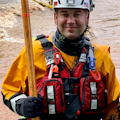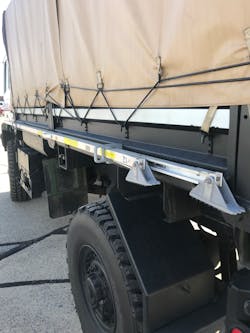Technical Rescue: High-Water-Vehicle Operations
Communities face increasing challenges with urban flooding. Because of the widespread effect of these events, fire departments are forced to become more self-sufficient. High-water vehicles (HWVs), which are large trucks that are adapted for water rescue, are becoming a go-to tool in department operations.
Understanding the selection, outfitting and operations of and training for HWVs provides the best outcomes for survivors and responders.
Vehicle selection
Military and commercial vehicles commonly are modified into HWVs for fire departments’ needs. These vehicles operate in water that’s moving at as fast a 3 mph.
The standard water fording depth on HWVs is 30 inches, which typically is just above the bottom of the vehicle’s frame rails. (Thirty inches is deep enough for small boats to be used instead.) Going deeper than 30 inches with an HWV might endanger the crew and damage the vehicle. Spinning cooling fans can shatter when they hit the water, and damage to electrical components is a risk. The vehicle still might operate during the rescue, but it could require expensive repair and time out of service.
- Andrew McIntyre will present “Urban Water Rescue Considerations” at Firehouse Expo 2023.
Ultimately, the vehicle’s exhaust location dictates the water depth for operations. If the exhaust is vented high, the work area must be protected and well ventilated.
Canopies that cover the work area of the vehicle can be constructed out of canvas or metal. When a canvas canopy is used, its sides should be rolled up and secured before the vehicle is driven into the water—or they simply can be removed. Metal canopies are great for scene and work area lighting. However, they should have large openings, to provide for emergency egress along the sides of the vehicle.
HWVs typically operate on hard surfaces, although there might be times when off-road capabilities are needed. Tires should be evaluated for both on-road and off-road performance. Military trucks come with adequate tires, but commercial vehicles typically are on-road use only. The vehicle’s tire size is a consideration for work area height, because it determines the distance from the bottom of the bed to the ground.
Payload or work area capacity depends on vehicle type, number of seats and how many personal flotation devices (PFDs) are available. Nonslip surfaces are needed for rescuer and survivor footing around the vehicle. However, ladder treads and bed lining shouldn’t be too coarse, because survivors often are barefoot.
Working off of the back of the vehicle is easier with the addition of a large platform. The platform should span the width of the work area and be at least 24 inches deep, so the feet of a rescuer who is standing sideways on the platform can be shoulder-width apart for secure footing. The platform adds height, so steps that swing down off of the bed should be added so that people can access the vehicle easily.
Rear platforms that have side steps that are integrated into them, much like a ladder truck, are another option.
Grab handles are a must for the rear of the vehicle; survivors need them for climbing up, and rescuers need them to grasp or clip into when they wear a harness. Openings and steps on a side of the vehicle are a useful addition. Side openings can be used to retrieve survivors who are seated on top of an automobile. This approach is easy for the driver or spotter to gauge and offers a safe enclosure for a rescuer to stand during the rescue.
Vehicle outfitting
HWVs are expected to perform in extreme conditions. As a result, they often are compromised by heavy rain and low light. Lighting components on these vehicles is a key consideration, and light placement should account for these challenges.
The ground area should be well lit, so the crew has good road and water condition visibility. Forward-facing scene lights should be positioned above the 30-inch level for fording but below the windshield, so rain doesn’t obscure the driver’s line of sight. Spot or flood lights for distance can be mounted on cab roofs or a metal canopy.
Light for the work area must be consistent throughout. However, avoid placing lights in a way that might shine into the eyes of rescuers and survivors who are at the back of the vehicle. Some departments successfully specified LED rope lighting across the canopy braces to provide work area lighting while limiting glare. Others specified high-mounted lamps, with additional focused lighting on the steps and at the rear of the vehicle.Flood rescue emergencies often are wide-area events that involve multiple units. Investing in hand lights that remain with the vehicle saves time and effort during these events.
When in operation, HWVs are surrounded by water and, so, are outfitted similarly to a boat. A person-overboard situation is just as likely to occur with a water-fording vehicle as it is with a boat. An accessible throw bag and life ring always should be available.
One of the first actions that any crew takes is to get a PFD on the survivor. However, PFDs should be provided for all of those who are on the HWV. Murky water across roadways can hide compromised road conditions during an evacuation. This could cause the vehicle to tip over and spill passengers into the water.
PFDs, ropes, suits and other equipment can be stored in the work area. Most companies use top-opening utility chests to line the sides of the area. These boxes then can double as seats for evacuees.
It’s important to note that structural turnout gear never should be worn during flood rescue operations. This established rule for boat rescue often is overlooked when using adapted vehicles in floods. Turnout gear becomes waterlogged and interferes with responder mobility.Operations
Driving on flooded roadways presents a host of possible hazards. Flood waters have moving currents that are choked with debris that can damage road surfaces. Hazards also include open sewer covers, storm drains, large, submerged debris and fallen wires—all hidden under brown, murky water.
Best practice is to drive in the center of the road, where water levels will be slightly lower and the vehicle is kept away from the road’s edges. (Most roads have a crown to them, a higher center that slopes to the sides.) However, flood-level water can flow across the road’s surface. This amount of water can undermine and wash away the sides of the road below the pavement. Low areas, where culverts pass under the road, are particularly susceptible to washouts, because debris builds up and clogs these passages.
The exception to driving in the center of the road is along a river road. A road that follows the edge of a swollen creek or river might be undermined along the side that’s closest to the river. Drive on the side that’s farthest from the river. When possible to do safely, have spotters walk ahead of the vehicle with poles.
It’s important to drive slowly through flooded water. Driving at high speeds through a flooded street can cause waves that lift and move swamped cars. Limit HWV driving speeds as you might do when boating in a no-wake zone.
Dirty flood water makes keeping track of the road difficult. Telephone poles and signs might not follow the road as expected. (Improvements over time can change a road’s direction, while the poles remain in their original locations.) In rural areas, mailboxes are a better clue to a road’s true location, because they are placed directly along the road to provide access to postal vehicles.
Watch carefully for changes and disturbances on the water surface. They help to identify areas that should be avoided. Circling trash and debris is a sign of an open sewer access, while white foaming water can indicate objects or a sudden drop.
Using your phone’s or iPad’s navigation app with Street View is a good trick to determine one’s location and what the area looks like dry. It won’t directly help with water depth but can locate sewer covers and side obstructions, such as guards or culverts.
The mothership, or lily pad, practice is one of the more efficient uses of an HWV. The vehicle is stopped in one spot (an intersection is best), and boats bring survivors to the vehicle. Once filled, the HWV is driven to dry land for people to disembark. This practice works best when a one-way pattern is established to avoid requiring vehicles to move toward the sides of the road to pass each other.
When the number of people to be moved requires multiple truckloads, a coordinator at the load site saves time. The coordinator keeps track of houses that were evacuated and the number of survivors and, most importantly, keeps boats and vehicles operating at their most efficient.Training
Many responders lack in-depth experience with HWVs. Therefore, training in the use of these vehicles in water is essential. Ideally, training sites should resemble a real-world rescue scenario. Close attention to water dynamics and how they affect the vehicle’s operation should be included as a core aspect of training.
Practicing in-water boat approaches can be difficult logistically. Boat ramps that enter a moving river offer the most realistic scene. The vehicle is backed down the ramp to a 30-inch level, and boats approach and transfer people between them. Survivor PFDs should be part of this drill, because it will let you know whether you have enough. Adding some bags and a pet carrier that has a loose bowling ball in it will be even more realistic.
Basic in-house drills also benefit drivers, spotters and crew.
Driver training should include normal road negotiation and practicing in tight quarters. Placing a person on top of an automobile, approaching the individual with the HWV and transferring the “survivor” has tremendous value. This type of practice teaches sightlines, approach and communications between crew members. It shows team members the best way to grab or stand.
Practice at night can help to familiarize with the process of evaluating lighting.
About the Author

Andrew McIntyre
Andrew McIntyre has been in the fire service since 2003, serving in both career and volunteer departments, on urban search and rescue teams, and as an instructor. Further work as a whitewater river guide, ski patroller, scuba divemaster and mountaineer brings a wide range of knowledge and experience. McIntyre is a U.S. Marine Corps. infantry veteran.

Joe Gribbins
Joe Gribbins has more than 40 years in the fire service and has been teaching water rescue since 1996. Gribbins recently retired as career captain in a New Jersey fire department. He is a 19-year member of New Jersey Task Force 1 Urban Search and Rescue who serves in the hazmat component and is the flood component representative. Gribbins can be reached at: [email protected].



